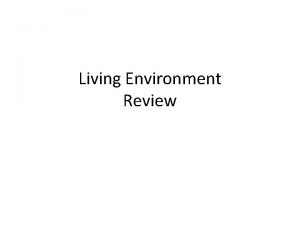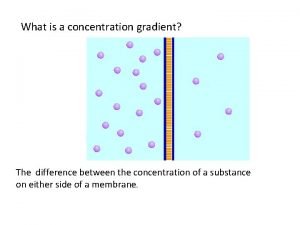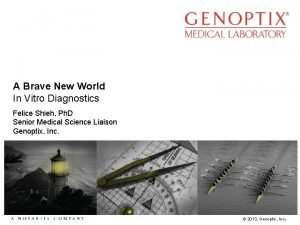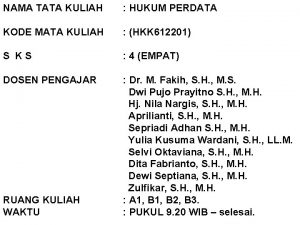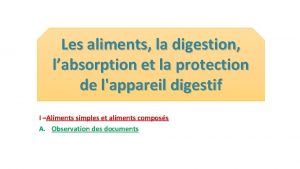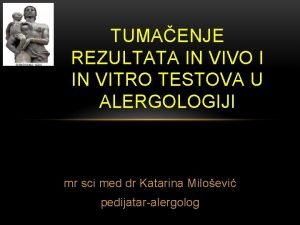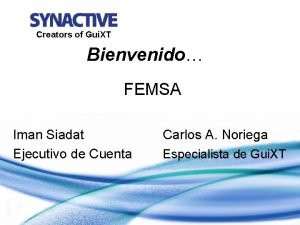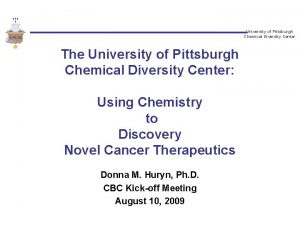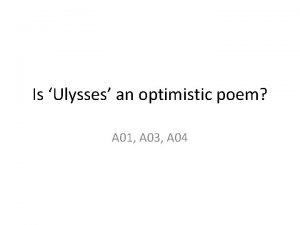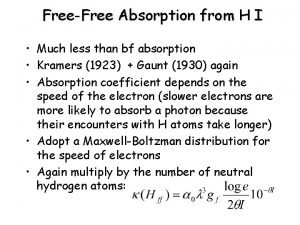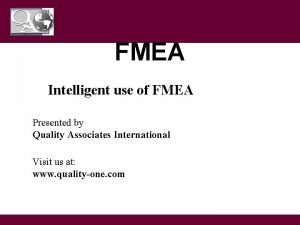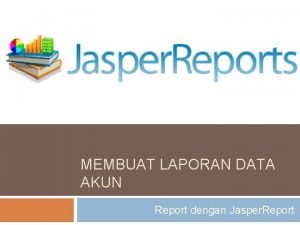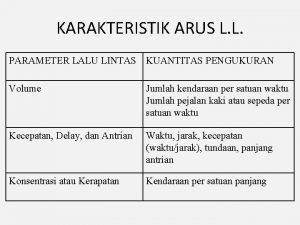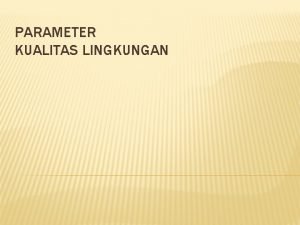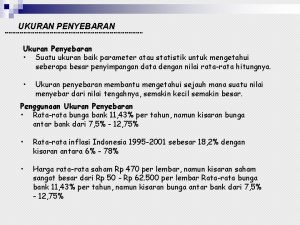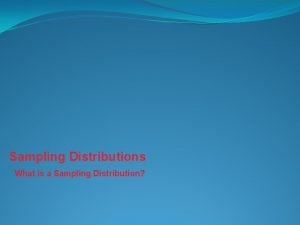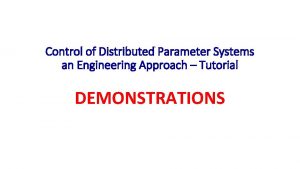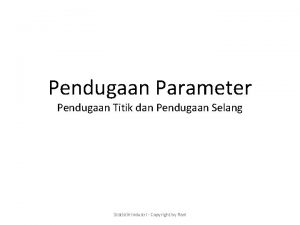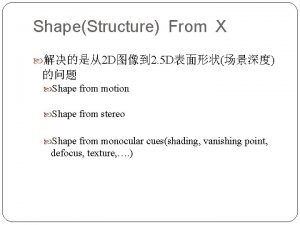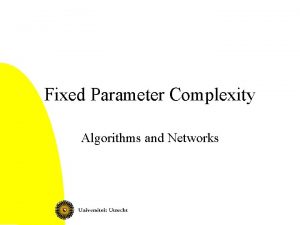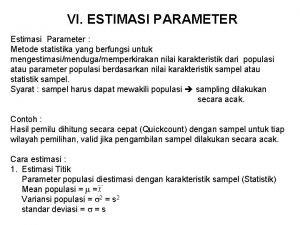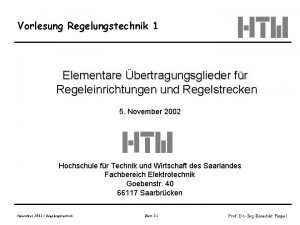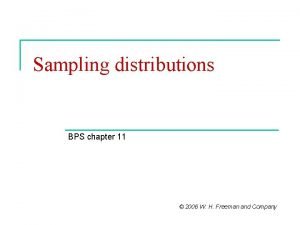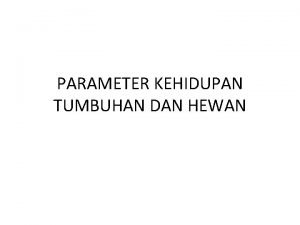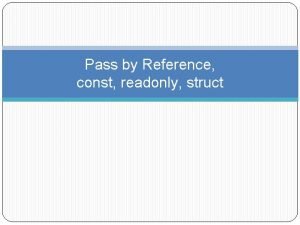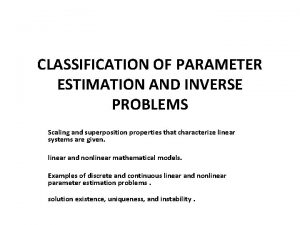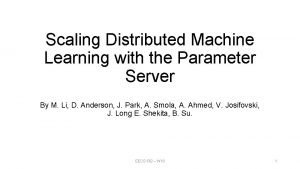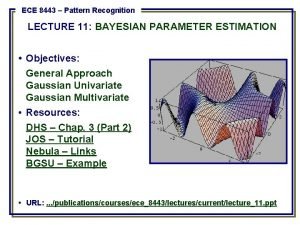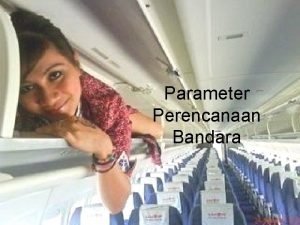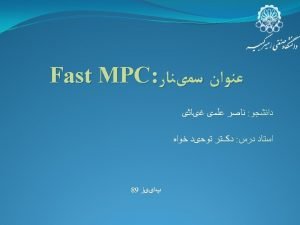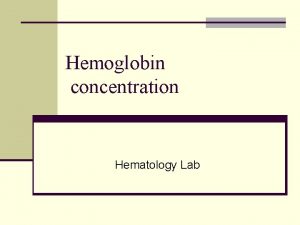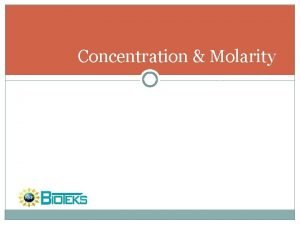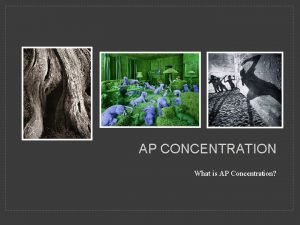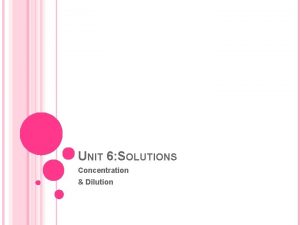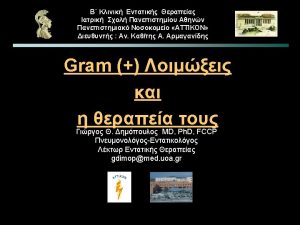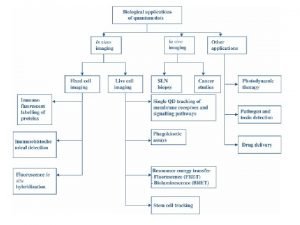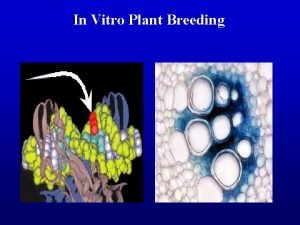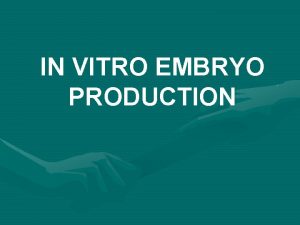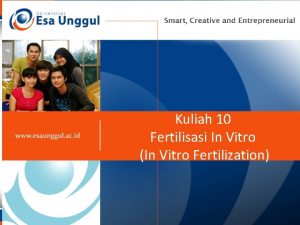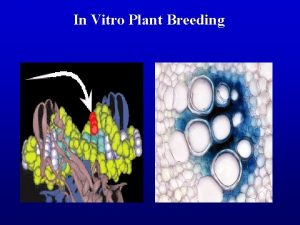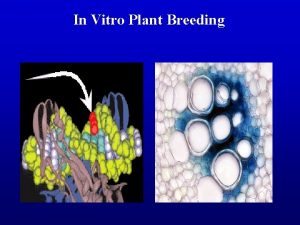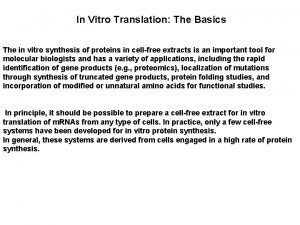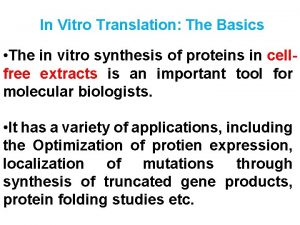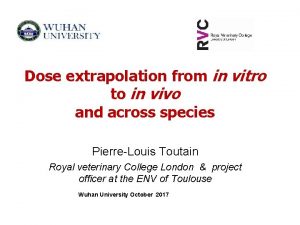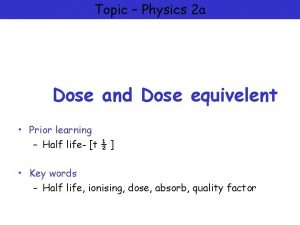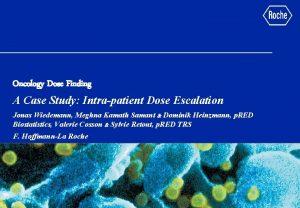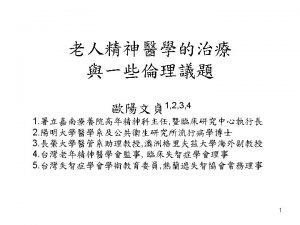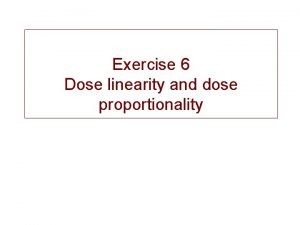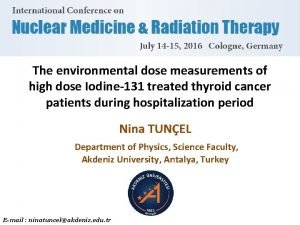Free concentration as dose parameter in in vitro








































- Slides: 40

Free concentration as dose parameter in in vitro and in vivo (eco)toxicology Joop Hermens Institute for Risk Assessment Sciences, Utrecht University The Netherlands

Our experience at EPA Duluth, 1987

EPA Environmental Research Laboratory My perspective on what was going on in 1987: § § § QSAR Mixtures Modes of action Start of in vitro (eco)toxicology Extrapolations

Extrapolation James M. Mc. Kim: from fathead minnow to lake trout

Extrapolation from fathead minnow to lake trout: instruments tests with lake trout micro dialysis kinetic model From: Erickson, R. J. and J. M. Mc. Kim. Aquat. Txicol. 1990, 18, 175 -198. Mc. Kim, J. M. , S. Naumann, D. E. Hammermeister, A. D. Hoffman and C. D. Klaassen. Fundam. Appl. Toxicol. 1993, 20, 190 -198.

James M. Mc. Kim et al. Fund. Appl. Pharmacol. 20, 190198, 1993 Mc. Kim, J. M. , S. Naumann, D. E. Hammermeister, A. D. Hoffman and C. D. Klaassen (1993). In vivo Microdialysis Sampling of Phenol and Phenyl Glucuronide in the Blood of Unanesthetized Rainbow-Trout - Implications for Toxicokinetic Studies. Fundam. Appl. Toxicol. 20, 190 -198.

Mc. Kim, 1993: The free or unbound component of any drug or toxicant is the form of primary concern in both pharmacological and toxicological evaluations. Here is where my contribution starts: Free concentration as dose parameter in in vitro and in vivo (eco)toxicology

Outline The issue of free concentrations in: § In vitro studies: biotransformation, membrane permeability and in vitro effect studies (cytotoxicity) § Extrapolation of in vitro to in vivo effect concentrations § In vivo accumulation and toxicity tests Our own research, free concentration measurements in: § Toxicity tests in sediment/soil § Accumulation studies § In vitro systems Technical remarks

In vitro studies: cytotoxicity Low albumin concentration High albumin concentration Cell protein contents in cultures of proliferating Balb/c 3 T 3 cells. (○) 18 μM and (▪) 600 μM BSA. Gülden M. et al. Toxicol. Letters 2003, 137, 159 -168.

Bioavailability and exposure concentrations in in vitro tests Several components in a culture dish compete for chemical Atmosphere Cell culture vessel Medium Components (serum proteins) Cells Picture from Kristin Schirmer

Dosing in in vivo tests Diluter system based on Benoit, EPA, Duluth

Bioavailability and exposure concentrations in in vitro tests Free concentration in medium = more intrinsic dose parameter.

Extrapolation of in vitro to in vivo effect concentrations Nominal concentrations in vivo LC 50 Precision: cell line 10 -1000 times less sensitive (low absolute agreement) in vitro EC 50 Gulden, M. ; Seibert, H. Aquat. Toxicol. 2005, 72, 327 -337.

Extrapolation of in vitro to in vivo effect concentrations Calculated free concentrations in vivo LC 50 in vitro EC 50 Gulden, M. ; Seibert, H. Aquat. Toxicol. 2005, 72, 327 -337.

In vivo accumulation and toxicity tests: effect concentrations in soil Effect concentration of chemical X: Sandy soil: 11 mg/kg soil Bioavailability depends on soil type Free pore water concentration = more intrinsic dose parameter. Clay soil: 120 mg/kg soil

Freely dissolved concentration is a more intrinsic dose parameter exposure External Dose: food, air water, soil Internal dose Target dose Free concentration Interaction with target hazard risk Effects Risks

Outline The issue of free concentrations in: § PBPK modeling § In vitro studies: biotransformation, membrane permeability and in vitro effect studies (cytotoxicity) § Extrapolation of in vitro to in vivo effect concentrations § In vivo accumulation and toxicity tests Our own research: free concentration measurements in: § Toxicity tests in sediment/soil § Accumulation studies § In vitro systems Technical remarks

Measurement of free concentration May look very simple, but!!: In vitro test in well plate well 20 u. L to 1 m. L Sediment slurry

Sampling techniques for measuring free concentration § § § § equilibrium dialysis micro dialysis ultrafiltration ultracentrifugation headspace analysis semi permeable membrane devices (SPMD) solid phase partitioning (empore disk, POM, SPME)

Sampling techniques to measure free (=active) concentration SPME: Solid phase micro-extraction with negligible depletion (nd SPME) Soil or sediment slurry or aqueous phase with dissolved matrix (DOC, proteins) X(bound) SPME fiber Xa(free) ~ 0. 1 -1 µL hydrophobic phase Vaes W. H. J. et. al. Anal. Chem. 1996, 68, 4463 -4467. Mayer P. et al. Environ. Sci. Technol. 34, 2000, 5177 -5183. Heringa M. B. et al. Anal. Chem. 2002, 74, 5993 -5997. Ter Laak T. L. et al. Environ. Sci. Technol. 2005, 39, 3736 -3742. Parkerton, T. F et al. 2000. Toxicol. Lett. 112, 273 -282. polymer coated glass fibers

Example 1: Free concentrations of PAHs in soil: experimental set up Ter Laak, T. L. et al. Environ. Sci. Technol. 2006, 40, 2184 -2190. PAHs

Free concentrations of PAHs in soil: experimental set up Field sample Extraction of fibers Chemical analysis

Method development for SPME sampler (free concentrations of PAHs in soil pore water) Calibration: C fiber against C aqueous K fiber-water = C fiber / C aqueous fiber C aqueous (free) = C fiber / K fiber-water Ter Laak, T. L. et al. Environ. Sci. Technol. 2006, 40, 2184 -2190.

One of the results: saturation of pore water in soil (Thomas ter Laak) Saturation of aqueous phase (at aqueous solubility) Caqueous Csoil Ter Laak T. L. et al. Environ. Sci. Technol. 2006, 40, 1307 -1313.

Example 2: Bioassay in soil with cypermethrin (Thomas Hartnik) Concentration in pore water (Ca) Norwegian soil Sound soil (low org. carbon) Concentration in soil (Cs) – mg/kg Total concentration in soil is used in risk assessment, but this is often not the right dose parameter. Thomas Hartnik, 2005, unpublished.

Example 3: Bioaccumulation in fish - the bioconcentration factor (BCF) In vivo Veith, G. D. et al. J. Fish. Res. Board Can. 1979, 36, 1040 -1048.

Relation bioconcentration facors and hydrophobicity (Kow): linear vs. non-linear models Reduced uptake? 1. effect of size exclusion? , or 2. overestimation of aqueous concentration (Ca) due to binding of a hydrophobic chemical to particles or DOC? BCF = Co / Ca = kw / ke

BAF in earthworms based on measured freely dissolved concentrations in soil pore water (Leon van der Wal) BCF increases also at high Kow BCF = C worm / C pore-water C free in pore-water measured via nd-SPME van der Wal, L. , T. Jager, R. H. L. J. Fleuren, A. Barendregt, T. L. Sinnige, C. A. M. van Gestel and J. L. M. Hermens Environ. Sci. Technol. , 2004, 38, 4842 -4848.

Example 4: Free concentration in an estrogenicity reporter gene assay (Minne Heringa) fibre Viton™ lid with pierced hole well § § § Estrogenicity reporter gene assay with 293 HEK cells with ER (Hubrecht laboratory). 24 -well plate. Test chemicals: estradiol and octylphenol. Heringa M. B. et al. Anal. Chem. 2002, 74, 5993 -5997.

Total vs. free concentration of octylphenol in an estrogenicity reporter gene assay Dose Nominal / total concentration Free aqueous concentration Heringa M. B. et al. Environ. Sci. Technol. 2004, 38, 6263 -6270.

Ranking of chemicals may depend on dose parameter A B B Nominal concentration A Free concentration Nominal or total concentration is often used in interpreting toxicological effect studies, this is often not the right dose parameter.

Modeling to estimate free concentration in an in vitro test Atmosphere K air-water (Henry’s law constant) Cell culture vessel K protein-water (a. o. Kow) Medium Components (serum proteins) K cell-water (a. o. Kow) Cells Nynke Kramer (EU project) + CEFIC-LRI project Picture from Kristin Schirmer K well plate-water (a. o. Kow)

Outline The issue of free concentrations in: § PBPK modeling § In vitro studies: biotransformation, membrane permeability and in vitro effect studies (cytotoxicity) § Extrapolation of in vitro to in vivo effect concentrations § In vivo accumulation and toxicity tests Our own research, free concentration measurements in: § Toxicity tests in sediment/soil § Accumulation studies § In vitro systems Technical remarks

Sampling techniques for organics Calibration Uptake kinetics 150 100 Cfiber 50 0 0 100 200 time (minutes) 300 Caqueous(free) In most cases equilibrium measurements of free concentration with calibration curve or via known Kfiber-water. Ca = Cfiber / K fiber-water

Influence of matrix (humic acids) on uptake kinetics of organic contaminants in SPME sampler Matrix may shorten equilibration times of fiber uptake. Similar effects may occur in vivo. Oomen, A. G. et al. 2000. Anal. Chem. 72, 2802 -2808. Heringa, M. B. and Hermens, J. L. M. 2003. Trends Anal. Chem. 22, 575 -587.

A simple set up for measuring sorption coefficients: Example: sorption of PAHs to humic acids Ter Laak, T. L. et al. 2005. Environ. Sci. Technol. 39, 3736 -3742.

Mc. Kim, 1993: The free or unbound component of any drug or toxicant is the form of primary concern in both pharmacological and toxicological evaluations. Information is relevant for: § § § Interpreting in vitro tests Interpreting in vivo tests Extrapolation of in vitro to in vivo

Acknowledgements § § Thomas ter Laak Nynke Kramer Steven Droge Angeles Rico § Chiel Jonker § § § Minne Heringa Leon van der Wal Heather Leslie Philipp Mayer Wouter Vaes Technicians: § Arjan Barendregt § Theo Sinnige § Frans Busser Modeling: Jan van Eijkeren (RIVM)


Dosing in in vivo tests versus in vitro tests Diluter system based on Benoit, EPA, Duluth
 Movement of high concentration to low concentration
Movement of high concentration to low concentration Concentration gradient
Concentration gradient Felice shieh
Felice shieh Pembuahan in vitro
Pembuahan in vitro Suc digestif
Suc digestif Ukupni ige referentne vrednosti
Ukupni ige referentne vrednosti Procedure for isolation of cell for in vitro culture
Procedure for isolation of cell for in vitro culture Sap netweaver portal vitro
Sap netweaver portal vitro Vitro data center
Vitro data center A free map determines which blocks are free, allocated.
A free map determines which blocks are free, allocated. Gibbs free energy and spontaneity
Gibbs free energy and spontaneity Helmholtz free energy and gibbs free energy
Helmholtz free energy and gibbs free energy Gibbs free energy non standard conditions
Gibbs free energy non standard conditions Summary of the story of an hour
Summary of the story of an hour Free hearts free foreheads
Free hearts free foreheads How to calculate gibbs free energy of a reaction
How to calculate gibbs free energy of a reaction Free-free absorption
Free-free absorption Fmea boundary diagram example
Fmea boundary diagram example Script html
Script html Parameter lalu lintas
Parameter lalu lintas Sap pxa_no_shared_memory
Sap pxa_no_shared_memory Parameter fisik kualitas air
Parameter fisik kualitas air Ukuran penyebaran adalah
Ukuran penyebaran adalah Parameter example statistics
Parameter example statistics Distributed parameter systems
Distributed parameter systems Penduga titik adalah
Penduga titik adalah Colorize photo
Colorize photo Fixed parameter
Fixed parameter Pengertian estimasi dalam statistik
Pengertian estimasi dalam statistik übertragungsbeiwert regelstrecke
übertragungsbeiwert regelstrecke Parameter and statistics
Parameter and statistics Variation of parameters
Variation of parameters P-attestation-indicator
P-attestation-indicator Jenis passing parameter
Jenis passing parameter Parameter tumbuhan
Parameter tumbuhan Pass by value parameter
Pass by value parameter Advantages of pultrusion process
Advantages of pultrusion process Parameter estimation and inverse problems
Parameter estimation and inverse problems Parameter server for distributed machine learning
Parameter server for distributed machine learning A parameter is a numerical description of a
A parameter is a numerical description of a Bayesian parameter estimation in pattern recognition
Bayesian parameter estimation in pattern recognition
